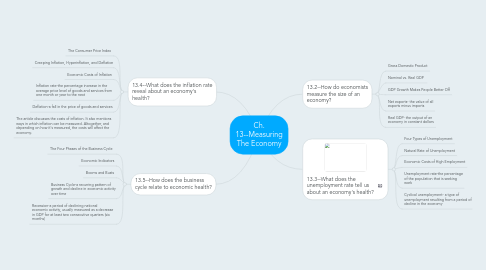Ch. 13--Measuring The Economy
by Heather Talma

1. 13.2--How do economists measure the size of an economy?
1.1. Gross Domestic Product
1.2. Nominal vs. Real GDP
1.3. GDP Growth Makes People Better Off
1.4. Net exports- the value of all exports minus imports
1.5. Real GDP- the output of an economy in constant dollars
2. 13.3--What does the unemployment rate tell us about an economy's health?
2.1. Four Types of Unemployment
2.2. Natural Rate of Unemployment
2.3. Economic Costs of High Employment
2.4. Unemployment rate-the percentage of the population that is seeking work
2.5. Cyclical unemployment- a type of unemployment resulting from a period of decline in the economy
3. 13.4--What does the inflation rate reveal about an economy's health?
3.1. The Consumer Price Index
3.2. Creeping Inflation, Hyperinflation, and Deflation
3.3. Economic Costs of Inflation
3.4. Inflation rate-the percentage increase in the average price level of goods and services from one month or year to the next
3.5. Deflation-a fall in the price of goods and services
3.6. The article discusses the costs of inflation. It also mentions ways in which inflation can be measured. Altogether, and depending on how it's measured, the costs will affect the economy.
4. 13.5--How does the business cycle relate to economic health?
4.1. The Four Phases of the Business Cycle
4.2. Economic Indicators
4.3. Booms and Busts
4.4. Business Cycle-a recurring pattern of growth and decline in economic activity over time
4.5. Recession-a period of declining national economic activity, usually measured as a decrease in GDP for at least two consecutive quarters (six months)


